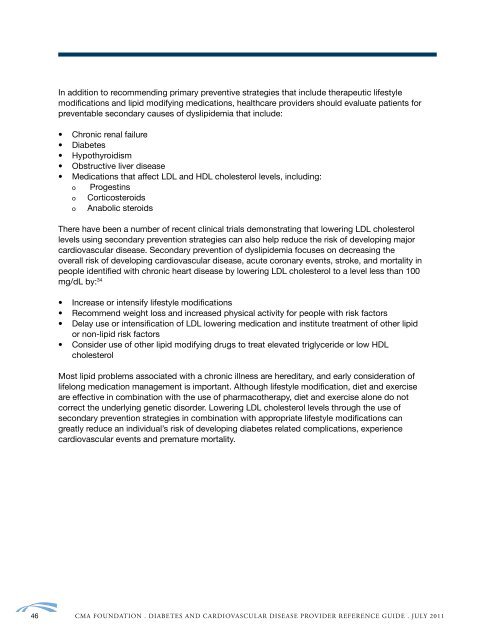Type 2 Diabetes Adult Outpatient Insulin Guidelines - CMA Foundation
Type 2 Diabetes Adult Outpatient Insulin Guidelines - CMA Foundation
Type 2 Diabetes Adult Outpatient Insulin Guidelines - CMA Foundation
You also want an ePaper? Increase the reach of your titles
YUMPU automatically turns print PDFs into web optimized ePapers that Google loves.
In addition to recommending primary preventive strategies that include therapeutic lifestyle<br />
modifications and lipid modifying medications, healthcare providers should evaluate patients for<br />
preventable secondary causes of dyslipidemia that include:<br />
• Chronic renal failure<br />
• <strong>Diabetes</strong><br />
• Hypothyroidism<br />
• Obstructive liver disease<br />
• Medications that affect LDL and HDL cholesterol levels, including:<br />
o Progestins<br />
o Corticosteroids<br />
o Anabolic steroids<br />
There have been a number of recent clinical trials demonstrating that lowering LDL cholesterol<br />
levels using secondary prevention strategies can also help reduce the risk of developing major<br />
cardiovascular disease. Secondary prevention of dyslipidemia focuses on decreasing the<br />
overall risk of developing cardiovascular disease, acute coronary events, stroke, and mortality in<br />
people identified with chronic heart disease by lowering LDL cholesterol to a level less than 100<br />
mg/dL by: 34<br />
• Increase or intensify lifestyle modifications<br />
• Recommend weight loss and increased physical activity for people with risk factors<br />
• Delay use or intensification of LDL lowering medication and institute treatment of other lipid<br />
or non-lipid risk factors<br />
• Consider use of other lipid modifying drugs to treat elevated triglyceride or low HDL<br />
cholesterol<br />
Most lipid problems associated with a chronic illness are hereditary, and early consideration of<br />
lifelong medication management is important. Although lifestyle modification, diet and exercise<br />
are effective in combination with the use of pharmacotherapy, diet and exercise alone do not<br />
correct the underlying genetic disorder. Lowering LDL cholesterol levels through the use of<br />
secondary prevention strategies in combination with appropriate lifestyle modifications can<br />
greatly reduce an individual’s risk of developing diabetes related complications, experience<br />
cardiovascular events and premature mortality.<br />
46 <strong>CMA</strong> FoundAtion . diAbetes And CArdiovAsCulAr diseAse Provider reFerenCe guide . july 2011


